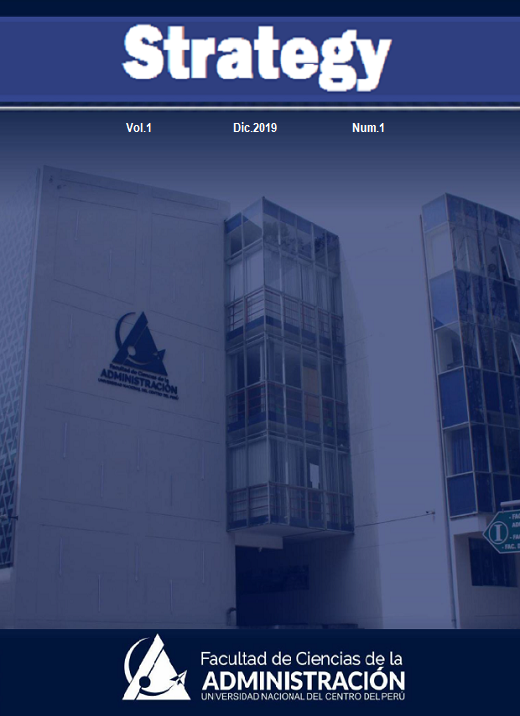Innovation and collaborative leadership in the National Institute of Radio and Television of Peru - Huancayo
DOI:
https://doi.org/10.26490/st.v1i1.718Keywords:
Innovation, Collaborative Leadership, Empathy, AdaptationAbstract
As a way of delimiting the problem; the integral problem that the National Institute of Radio and Television of Peru - Huancayo has institutionally gone through has not been addressed, but we will focus specifically on the relationship that exists between innovation and collaborative leadership in its workers to achieve the strengthening of institutional leadership. The financial factors, production, logistics, technology, remuneration and various negotiations that the institution has will be the subject of other investigations.
In the staff of the National Institute of Radio and Television of Peru - Huancayo, there is specifically a low level of job satisfaction. The workers do not find a motivation that activates them in their interest to work well, but only to fulfill. This problem is not only presented in the IRTP but also in most institutions of the Peruvian State. Therefore, the IRTP presents a weak culture, typical of organizations limited by rigid regulations, austere budgets and changing policies that significantly influence aspects such as team work, motivation, performance-stimulus, organizational culture and work environment.
The general problem of the investigation How is the relation of the innovation and the collaborative leadership in the National Institute of Radio and Television of Peru - Huancayo ?; the general objective was achieved, analyzing the relationship between innovation and collaborative leadership that strengthened the institutional leadership in the IRTP and concludes with the testing of the general hypothesis, the relationship between innovation and collaborative leadership is significant in the National Institute of Radio and Television of Peru - Huancayo.
With a level of significance of 0.05 and a confidence level of 95%, in that sense it is stated that the average of the post test is greater than the average of the pre-test, with this we affirm that the relationship between innovation and collaborative leadership is significant in the National Institute of Radio and Television of Peru - Huancayo.
With a level of significance of 0.05 and a confidence level of 95%, in that sense it is affirmed that the average of the post test (3.8371) is higher than the average of the pre-test (2.0868); with this we affirm that the relationship between innovation and empathy is significant in the National Institute of Radio and Television of Peru - Huancayo.
With a level of significance of 0.05 and a confidence level of 95%, in this sense it is affirmed that the average of the post test (3.8254) is higher than the average of the pre-test (2.1425); with this we affirm that the relationship between innovation and redarquía is significant in the National Institute of Radio and Television of Peru - Huancayo.
With a level of significance of 0.05 and a confidence level of 95%, in that sense it is affirmed that the average of the post test (3.9700) is higher than the average of the pre-test (2.1474); With this we affirm that the relationship between innovation and influence is significant in the National Institute of Radio and Television of Peru - Huancayo.
With a level of significance of 0.05 and a confidence level of 95%, in that sense it is affirmed that the average of the post test (3.7500) is higher than the average of the pre-test (2.050); with this we affirm that the relationship between innovation and adaptation is significant in the National Institute of Radio and Television of Peru - Huancayo.
Downloads
References
Archer, David; Cameron, Alex (2008). Liderazgo cooperativo - cómo tener éxito e interconectado mundo. Butterworth Heinemann. ISBN978-07506-8705-8.
Chrislip, David (2002). La colaboración Fieldbook liderazgo - una guía para los ciudadanos y líderes cívicos. Josey Bass. ISBN0-7879-5719-4.
Design Thinking en el aula: qué es y cómo aplicarlo. Universia. Recuperado de noticias.universia.es
Ejemplos de investigación aplicada. DPP 2013. Recuperado de dpp2013.wordpress.com
https://blogs.HBR.org/CS/2013/02/why_the_world _needs_tri-sector.html
https://blogs.HBR.org/CS/2013/02/why_the_world _needs_tri-sector.html
Investigación aplicada vs investigación pura (básica). Abarza. Recuperado de abarza.wordpress.com
Investigación Aplicada. Calameo. Recuperado de es.calameo.com.
Investigación aplicada: características, definición, ejemplos. lifeder.com
John Bessant , Joe Tidd.(2016) Innovación y Emprendedurismo Wiley, 2016 USA.
Kanter, Rosabeth Moss (2003). Rosabeth Moss Kanter en las fronteras de la gestión. Harvard Business Review (Harvard Business School Press). ISBN1-59139-323-X.
La investigación aplicada. Redalyc. Recuperada de redalyc.com.
Negocios asociaciones Survey. Ipsos MORI. 2007. de 2008-12-01.
Rubin, Hank (2009). Liderazgo colaborativo: Desarrollo de asociaciones eficaces para las comunidades y escuelas. Corwin Press.








